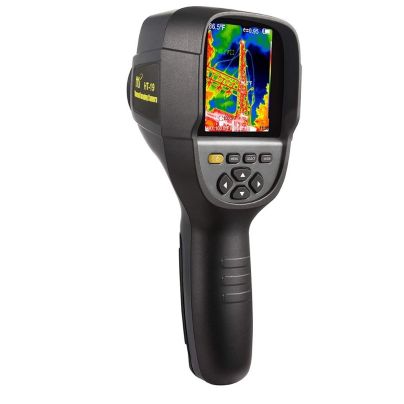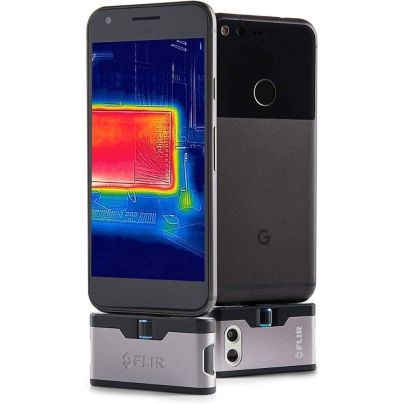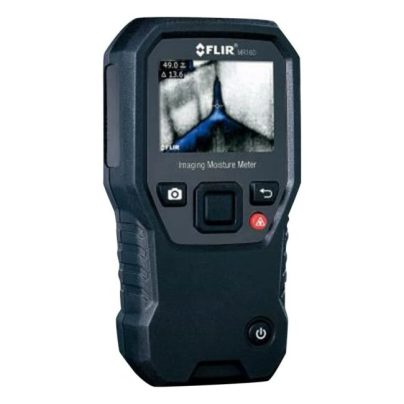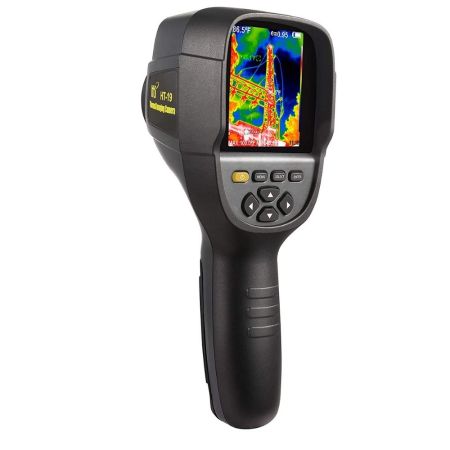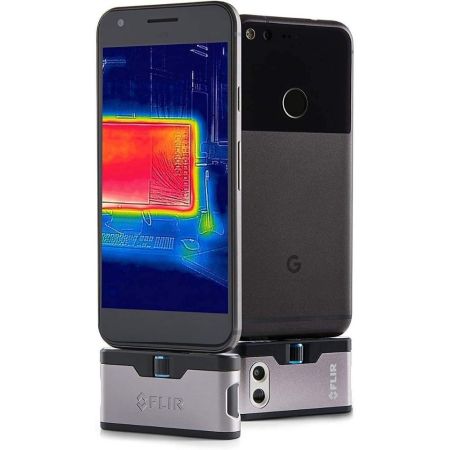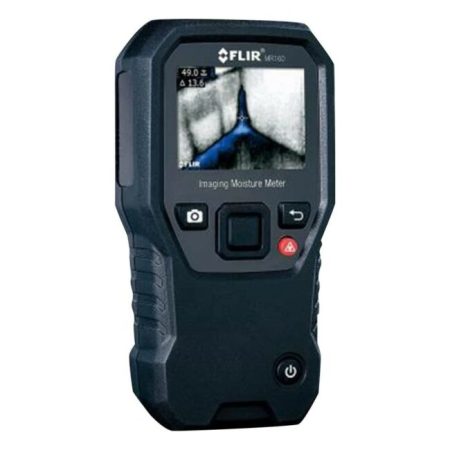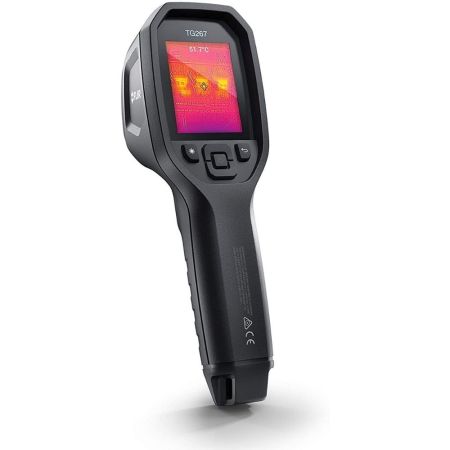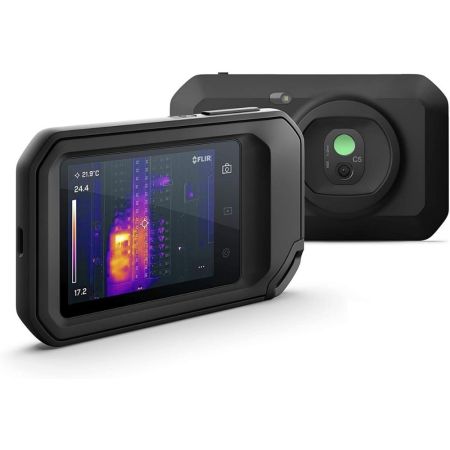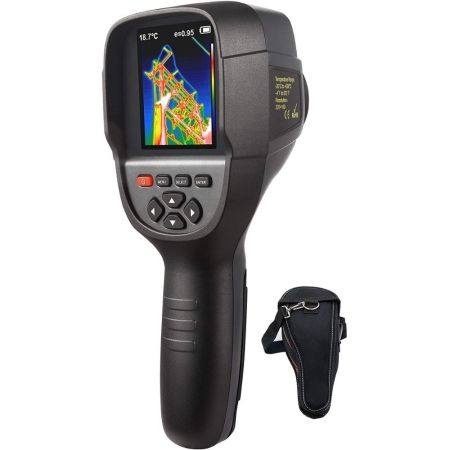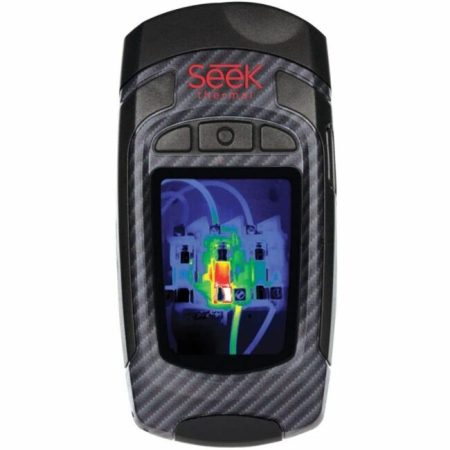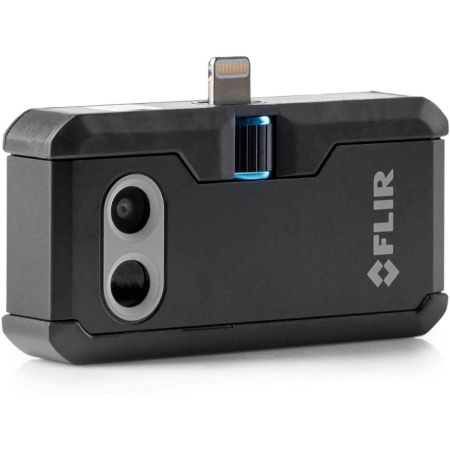We may earn revenue from the products available on this page and participate in affiliate programs. Learn More ›
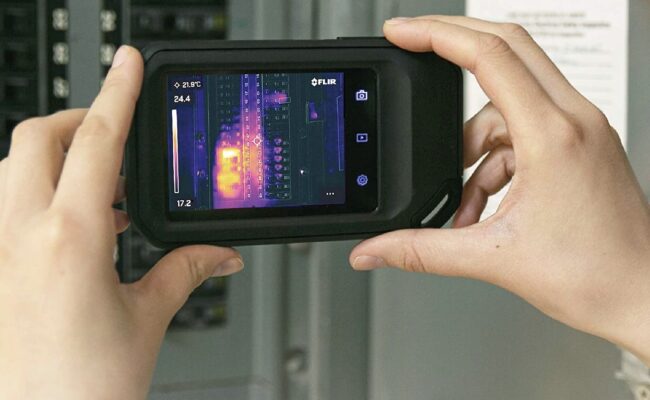
Thermal cameras can help detect potential issues in your home, such as a termite nest in the wall or a leak from a pipe. These devices detect and measure a heat signature, which is the infrared energy given off by most objects. The thermal camera converts this heat signature data into an electronic image for the human eye to view on a digital display.
Often used by electricians, building inspectors, exterminators, plumbers, and HVAC technicians, many of today’s thermal cameras are designed to be easy for nonprofessionals to operate. Take a look at this list of some of the best thermal cameras to get an idea of which product suits your needs.
- BEST OVERALL: Hti-Xintai HT-19 Thermal Imager
- BEST BANG FOR THE BUCK: Flir One Gen 3 Thermal Camera for Smart Phones
- BEST FOR HOME: Flir MR160 IGM Moisture Meter
- BEST MIDRANGE: Flir TG267 Thermal Camera
- BEST WITH WI-FI: Flir C5 Handheld Compact Thermal Camera
- BEST FOR ELECTRICAL CHECKS: Hti-Xintai HT-18 Thermal Imager
- BEST FOR LEAK DETECTION: Seek Thermal RevealPro Imaging Camera
- BEST SMARTPHONE ATTACHMENT: Flir One Pro LT Pro-Grade Thermal Camera
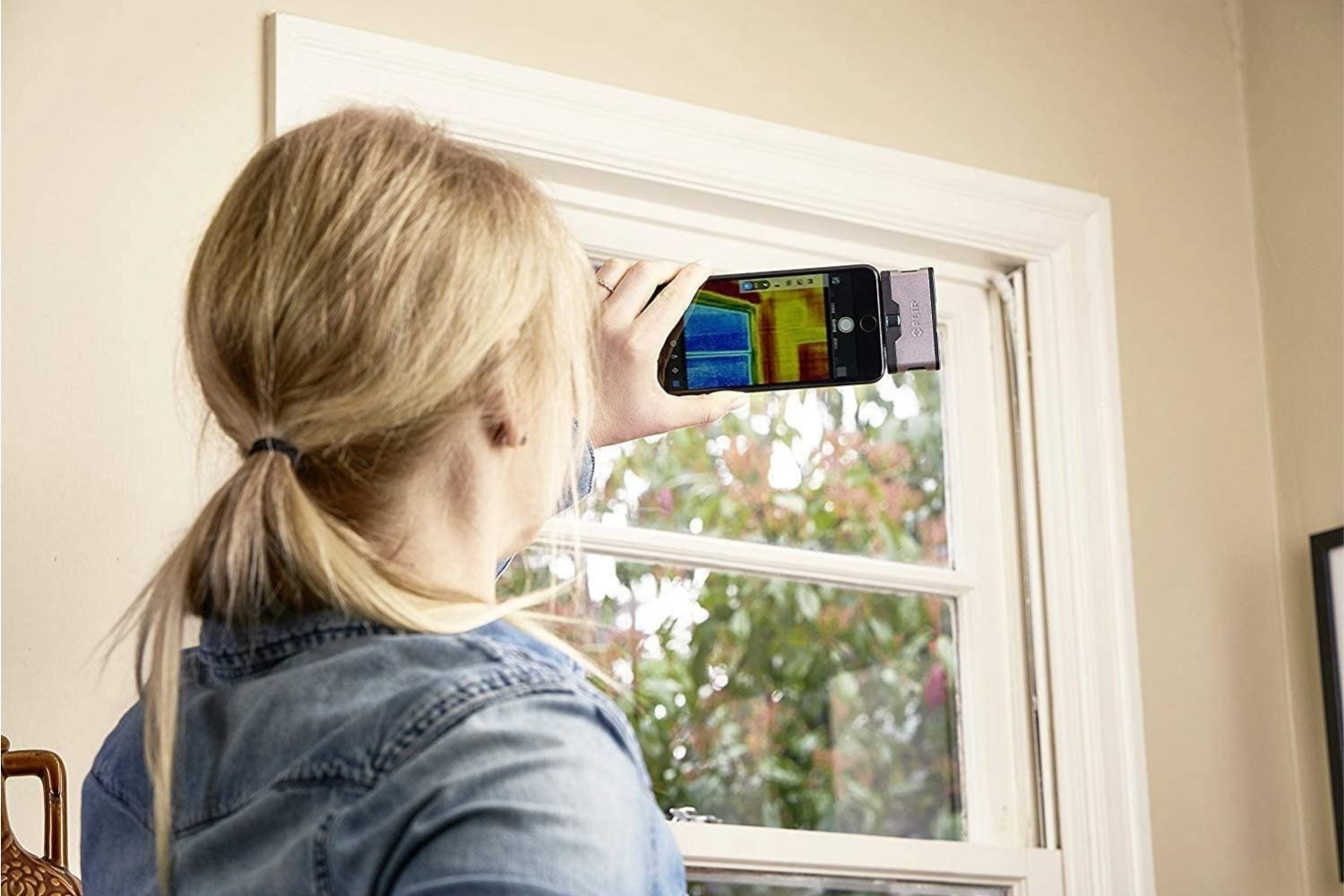
How We Chose the Best Thermal Cameras
Finding a leak, electrical error, or HVAC problem can prevent disastrous issues easily with the right thermal camera. Selections for the best thermal camera depended upon temperature range, resolution, weight, screen size, and other special features included.
These picks vary between handheld and smartphone types for lightweight, portable, and versatile use. The above list also prioritizes thermal sensitivity by detecting temperatures of -4 to 752 degrees Fahrenheit for observing electrical, HVAC, mechanical, or plumbing systems. As for visibility while you are checking for high temperatures, the above thermal cameras have high resolutions of up to 320-to-240 pixels. Plus, large LED screens on select products allow for even more clarity.
If you need to share your readings and heat detections, USB and mini USB cables or Wi-Fi connectivity allow users to save thermal images or permit photo-sharing. Finally, some of these picks are made with long battery life, included memory cards, and/or built-in secondary cameras.
Our Top Picks
Considering price, quality, and other important features described in detail later, this guide recommends the following products for detecting issues behind your walls.
Best Overall
Hti-Xintai HT-19 Thermal Imager
See ItProduct Specs
- Type: Handheld
- Temperature range: -4 to 572 degrees Fahrenheit
- Resolution: 320 by 240 pixels
- Weight: 0.85 pounds
Pros
- High resolution screen provides clear images that are easier to read than on some models
- Good for extended use; gripped handle increases comfort during use
- Built-in 3GM memory or option to transfer to another device
Cons
- Cannot be mounted on a tripod; limits its usability for longer projects
- USB cable does not project to big screen; requires purchase of additional cables
To ensure clear image quality of your housing system or your vehicle’s engine, a very high thermal resolution would be beneficial. This handheld thermal camera has a high resolution of 320 by 240 pixels and a 3.2-inch color display screen. A comfortable, lightweight grip makes it easy to use without hand fatigue.
Use this infrared camera for home inspections, firefighting, or even archaeology, and save pictures with the built-in 3GB memory card. The camera can also be connected to a laptop, television, or other compatible device using the micro USB cable to display photos or transfer files between devices. The infrared camera has a -4 to 572 degrees Fahrenheit temperature range and measurement accuracy of 2.4 degrees Fahrenheit.
Get the Hti-Xintai HT-19 thermal imager at Amazon.
Best Bang for the Buck
Flir One Gen 3 Thermal Camera for Smart Phones
See ItProduct Specs
- Type: Smartphone attachment
- Temperature range: -4 to 248 degrees Fahrenheit
- Resolution: 80 by 60 pixels
- Weight: 0.76 pounds
Pros
- Wi-Fi and mobile access enable instant photo and video recording and sharing
- Built-in secondary camera creates a blend of thermal and visual images
- Carrying case and USB cord included for neat and organized storage
- Versatile; compatible with a wide range of popular smartphone brands
Cons
- Some users report limited battery life and some software issues
Unless you are regularly taking thermal image scans, you probably don’t necessarily need a handheld thermal camera. Instead of emptying your wallet for a tool that you will rarely use, you can get this inexpensive smartphone thermal camera attachment to capture thermal readings from -4 to 248 degrees Fahrenheit. The attachment connects directly to the base of your smartphone, allowing you to use your smartphone as a thermal camera.
The thermal imager has an 80-by-60-pixel thermal resolution. It comes with a secondary camera that captures visual details to help create a blend of thermal and visible images. This feature makes it easier to identify the object that you are viewing. The connection with your phone provides immediate access to Wi-Fi or your mobile network so that you can send photos or videos from the thermal camera. This model also comes with a USB to USB C cord and carrying case for added ease of use and portability.
Get the Flir One Gen 3 thermal camera at Amazon.
Best For Home
Flir MR160 IGM Moisture Meter
See ItProduct Specs
- Type: Handheld
- Temperature range: 32 to 122 degrees Fahrenheit
- Resolution: 80 by 60 pixels
- Weight: Unspecified
Pros
- Flexible tool that includes multiple accessories, including moisture meter and laser crosshair display
- Robust materials provide good build quality; feels solid in the hand
- Condensation feature on the tool comes in handy in wet environments
Cons
- Temperature range is more limited than that of other options on this list
- No weight provided
Use this 80-by-60-pixel thermal resolution camera from Flir at home to capture the thermal images that can help to identify problem areas inside walls. The kit also comes with a thermal imaging moisture meter that can be used with the included hammer and wall moisture probes to provide an accurate measurement of moisture in the selected area of the home.
The thermal camera measures a temperature range of 32 to 122 degrees Fahrenheit and has an accuracy rating of just 3 degrees, while the moisture meter has both a pin and pinless function. This allows users to probe the target surface or simply scan the top layer. The thermal camera also has a laser crosshair display to better identify the area being scanned.
Get the Flir MR160 thermal camera at Amazon or B&H.
Best Mid-Range
Flir TG267 Thermal Camera
See ItProduct Specs
- Type: Handheld
- Temperature range: -13 to 716 degrees Fahrenheit
- Resolution: 160 by 120 pixels
- Weight: 0.86 pounds
Pros
- Stores over 50,000 images; ideal for frequent use on large projects
- Bluetooth connectivity enables easy file transfer, no cable connection is required
- Built-in laser pointer helps users focus on what they’re seeing inside the wall
Cons
- No carrying or storage case included; requires separate purchase or increased care during transport
The Flir TG267 Thermal Camera has a range of uses, from typical household inspections to measuring body temperature without needing to make contact. This contactless body temperature measurement ranges from 89.6 to 108.5 degrees Fahrenheit. However, the full temperature range is from -13 to 716 degrees Fahrenheit.
This handheld thermal imaging camera has an accuracy measurement of 3 degrees Fahrenheit, storage for up to 50,000 images, and Bluetooth connectivity for file transfers. The thermal resolution is 160 by 120 pixels. The camera has a thermocouple probe that can extend the sensor into the ventilation ducts or behind the walls. A built-in laser pointer displays a circle on the area you are measuring to identify where you are looking inside the wall.
Get the Flir TG267 thermal camera at Amazon or B&H.
Best With WiFi
Flir C5 Handheld Compact Thermal Camera
See ItProduct Specs
- Type: Handheld
- Temperature range: -4 to 752 degrees Fahrenheit
- Resolution: 160 by 120 pixels
- Weight: 6.72 ounces
Pros
- Compatible with a USB or micro USB cord; enables easy laptop transfer
- Wi-Fi capability offers automatic backup to the cloud; files are securely backed up
- Built-in LED display and great 160-by-120-pixel resolution
- Durable construction; comes with an IP54 rating against moisture and dust
Cons
- Flir Ignite account required for image sharing; might be a dealbreaker for some shoppers
- Fixed 3-foot range; may not be suitable for circuit-board use
Instead of relying on a handheld thermal sensor’s internal storage and transferring files through a USB or micro USB cord, this thermal imager can connect to Wi-Fi for automatic file backup on the cloud. This allows easier file transfer, file storage, and file sharing. The handheld thermal camera has a thermal resolution of 160 by 120 pixels for a detailed thermal image on its LED display.
This IP54-rated visual inspection camera has a visual light image enhancement floodlight to help identify objects and present them in a combined view. The camera can measure a temperature range of -4 to 752 degrees Fahrenheit with an accuracy rating of 4 degrees Fahrenheit and has a 3.5-inch integrated touchscreen for simple, effective control.
Get the Flir C5 thermal camera at Amazon, Walmart, or B&H.
Best for Electrical Checks
Hti-Xintai HT-18 Thermal Imager
See ItProduct Specs
- Type: Handheld
- Temperature range: -4 to 572 degrees Fahrenheit
- Resolution: 220 by 160 pixels
- Weight: 0.83 pounds
Pros
- 3.2-inch full-color screen with 5 color scales and high resolution
- 3GB memory card stores up to 20,000 thermal images, which is more than enough for most users
- Carrying case included to keep everything neat, protected, and organized
Cons
- Takes 2 hours to fully charge; not ideal for extended use
The electrical system in a home can be problematic if the wiring has many splices. Thermal imaging can show issues where the electrical resistance traveling through the wires has begun to build up in the system. This buildup can indicate a potential problem and can lead to a short in the wiring and dangerously hot electrical circuits.
This handheld thermal imager has a temperature range of -4 to 572 degrees Fahrenheit and a 220-by-160-pixel thermal resolution. This high resolution is displayed on the 3.2-inch full-color screen that has a choice among five color scales, including rainbow, iron red, cold color, black and white, or white and black to shift the color of the image.
This thermal imager has a measurement accuracy of 2.5 degrees Fahrenheit and a 3GB memory card to store up to 20,000 images, which users can transfer with the included USB cable.
Get the Hti-Xintai HT-18 thermal imager at Amazon.
Best for Leak Detection
Seek Thermal RevealPro Imaging Camera
See ItProduct Specs
- Type: Handheld
- Temperature range: -40 to 626 degrees Fahrenheit
- Resolution: 320 by 240 pixels
- Weight: 6.25 ounces
Pros
- High-resolution device with MicroSD card; ideal for detailed images
- Capable of reading temperatures at a 500-foot distance; great for large projects
- 4-hour battery life is long enough for most workdays
- 32-degree field of view allows the user to view multiple objects easily
Cons
- Despite a high resolution, the small screen provides limited visibility
For the construction site, plumber, or home, a small and light thermal camera that fits in your pocket and can withstand wear and tear is ideal. Use the ample 320-by-240-pixel thermal sensitivity to capture the thermal images that can help to identify problem areas inside your walls. Though the 300-lumen LED screen is small, it requires less charging time than typical thermal cameras and provides a 4-hour battery life.
This model can also save thermal images to its MicroSD card and it is capable of reading a temperature range of -40 to 626 degrees Fahrenheit from a 500-foot distance. It also comes with a 32-degree field of view, which aids in seeing multiple pipes and plumbing fixtures easily. Finally, this model comes with a USB cable and rubberized casing for abrasion and damage resistance.
Get the Seek thermal camera at Amazon.
Best Smartphone Attachment
Flir One Pro LT iOS Pro-Grade Thermal Camera
See ItProduct Specs
- Type: Smartphone attachment
- Temperature range: -4 to 248 degrees Fahrenheit
- Resolution: 80 by 60 pixels
- Weight: 1.28 ounces
Pros
- Sturdy, impact-resistant design withstands drops of up to 1.8 meters
- Connects through the Flir One app for video sharing; no cables needed
- Connector is adjustable to allow use with the phone case on
Cons
- Compatible only with either iOS or Android, not cross-compatible
- Short battery life of only 1 hour; not great for extended uses throughout the day
- 80-by-60-pixel resolution range is limited compared with that of other thermal imaging cameras
This smartphone thermal camera attachment is a lightweight alternative to a handheld thermal camera. It is impact-resistant for drops up to 1.8 meters. It has a helpful adjustable connector that extends out from the smartphone attachment so that you don’t have to remove your phone case to use this camera. The thermal camera works only with either iOS or Android devices, depending on the chosen model, and has an approximate rechargeable battery life of just 1 hour.
The thermal imager has an 80-by-60-pixel thermal resolution, producing time-lapse videos, regular videos, and still images that are saved in JPEG format. While this camera does not have the same range as a handheld thermal camera, it can measure temperatures between -4 and 248 degrees Fahrenheit within 4 degrees of accuracy. The camera also can connect through the free Flir One app to share live video from the camera or access helpful tools through the free Flir Tools app.
Get the Flir One Pro thermal camera at Amazon or B&H.
Jump to Our Top Picks
What to Consider When Choosing a Thermal Camera
The best thermal camera for you can depend on several factors, including the size, temperature range, resolution, image enhancement capabilities, and task-specific accessories, like wall probes for leak detection. Here are a few things to consider before selecting a thermal camera.
Types of Thermal Cameras
Thermal cameras are categorized into three main types based on how they are used. The types are handheld thermal cameras, smartphone thermal camera attachments, and thermal drones.
Handheld Thermal Cameras
Handheld thermal cameras are commonly used for household inspections and for many industrial applications. This type of thermal camera can have a small body the size of a smartphone, or it can be large enough that it’s helpful to hold it with a camera grip for proper focus.
For the majority of thermal camera applications where you will be looking inside a home’s walls, floors, or other spaces, a handheld thermal camera is suitable. While these cameras are larger and more expensive than a smartphone attachment, they also may have thermal camera-specific screen resolutions and a wide range of features, including contactless body-temperature readings, a built-in laser guide, or a visual light camera.
Smartphone Thermal Camera Attachments
A smartphone thermal camera attachment allows you to use your smartphone to see the heat signatures of infestations and your electrical, HVAC, and plumbing systems. The attachment plugs into the base of your device so that you can simply control the camera through your touchscreen and upload the collected pictures or scans directly into your phone.
This type of device is inexpensive and easy to use, making it a great option for infrequent or DIY home inspections, but it is not recommended for professional use. This is because smartphone thermal camera attachments lack the high image quality and precise measuring accessories that handheld thermal cameras will normally have. They also may drain your smartphone battery very quickly, which means that you would likely be limited to about an hour of continuous viewing.
Thermal Drones
The idea of thermal drones may seem a bit strange for a home inspection, but there are many issues that cannot be detected from inside the house. Unless you are willing to get up on a ladder, a thermal drone is a great way to find out if you have any hidden problems.
Possible problems that a thermal drone can help detect include nesting insects or other animals, blockages in your drainage system, and areas in your roof or exterior walls where heat is escaping, indicating the need to repair a hole. These devices combine the flight capability of a drone with the thermal detection abilities of a thermal camera. However, they are usually quite expensive and are usually better suited for those with a professional roofing or home inspection business.
Size, Weight, and Grip
The size and weight of a thermal camera is a necessary consideration for anyone who is planning on using it for an extended period of time. Whether a thermal camera will help reduce hand fatigue is collectively determined by the size, weight, and grip.
Small thermal camera smartphone attachments are easy to carry, but they don’t have the same kind of stable grip as thermal cameras. Smartphone attachments are great for travel and quick inspections, but they are not suited for long periods of use.
Handheld thermal cameras can range in size, but those best suited for comfort typically come with a padded camera grip that is easy and comfortable to hold. Thermal drones can range in size, but weight isn’t as much of a factor because they can fly. However, a drone controller that fits comfortably in your hand can make operating the drone easier and more precise for the entire flight time.
Temperature Range
When you are looking for a thermal camera you will notice that the manufacturer typically states the minimum and maximum temperatures that the camera is capable of accurately reading. Smartphone attachments normally have moderate thermal sensitivity from -4 to 248 degrees Fahrenheit, while handheld thermal cameras may extend the temperature range to between -13 to 716 degrees Fahrenheit.
The larger temperature ranges allow you to detect problems with the ignition of your HVAC system, hot water tank, or your vehicle. Thermal drones typically have a similar range as handheld thermal cameras, with the added bonus of flying. When shopping for a camera, keep in mind the highest and lowest possible temperatures that you would normally find during your inspection.
Resolution
The thermal resolution of your thermal camera is designed to help you find any potential issues. Not being able to pinpoint an issue may require cutting more holes or larger holes to fix an unclear problem.
For example, a low-resolution camera may present a broad spectrum image of your plumbing system that vaguely shows an increase in temperature that extends outside of the pipe. While it helps to determine that there is a hot water leak, it does not show the exact location of the leak. With a higher resolution camera, you can identify the flow of water and open a hole just wide enough to stop the leak.
For this purpose, you need a high enough thermal resolution to be able to accurately determine what you are seeing through the thermal camera screen. This helps prevent doubt regarding a potential abnormality that needs to be addressed. Thermal resolution quality is measured in pixels and can range from 60 by 60 pixel resolutions more commonly seen on smartphone attachments to as high as 320 by 240 pixels. The higher resolution may be necessary for professions that require precise thermal imaging tools.
Accuracy and Repeatability
The accuracy of thermal cameras is measured in degrees Celsius or degrees Fahrenheit, and it is used to help determine if there is a problem or if the readings are normal for your home’s systems. For example, the Occupational Safety and Health Administration suggests that your hot water heater heats water to a temperature of 140 degrees Fahrenheit to prevent the spread of certain diseases.
With your thermal camera you can verify that your hot water heater is performing to the appropriate standard or if it needs to be repaired or replaced. Typical thermal cameras have a range of plus or minus four degrees Fahrenheit, though there are more accurate thermal imaging cameras.
The plus or minus range that is offered as a general accuracy rating takes into account several factors that can affect how the infrared energy is being read. These can include ambient temperature, camera response, emissivity, transmittance, calibrator temperature accuracy, and atmospheric temperature. The more repeatable a result is, regardless of these intervening factors, the more accurate a camera will be.
Thermal Image Enhancement
Along with a high-definition thermal resolution, you may want a camera that can enhance the thermal image by using overlays of nonthermal video. This feature allows you to see low-contrast objects even in areas with very wide temperature ranges, allowing you to differentiate between two similar targets.
The result is a detailed thermal image produced by the thermal camera with overlays of sharp corners and edges from the visual camera to give the thermal image some identifiable structure. This feature can help identify studs in a wall, plastic pipes, and even furniture in a dark room. It also is typically used by firefighters to quickly identify their surroundings so that they can take appropriate actions to put out the fire and help anyone nearby.
Visible Light Image Enhancement
Thermal cameras do not typically need visual light in order to view a thermal depiction of an object or objects it is directed toward. However, it is easier to identify possible problems and anomalies in electrical, plumbing, HVAC, or even your vehicle engine if there is a structure for our eyes to see and identify.
To this end, some thermal cameras have a visual light enhancement feature that adds light to low-light video to better illuminate the outline and structure of the objects you are scanning. With this feature, you may also be able to change the visual tone and appearance on the screen so that you can find a visual output, which is like a photo filter, that gives you the best view of the problem.
File Formats and Data Output
Thermal cameras can be used to view and identify possible issues inside a wall. You also can take a picture or video to send to your repair technicians so that they are better informed before showing up to help fix it.
Home inspectors and many other industry professionals use thermal cameras regularly and need to be able to take photos, store them, and even send them wirelessly to others. Thermal cameras may have BMP or JPEG file formats; BMPs are problematic to convert into a readable form, while JPEGs can be read by most devices.
Data can be saved on the camera or it can be saved on your computer or another device. This usually requires a USB cord, but some cameras can connect to Wi-Fi. Smartphone thermal camera attachments connect directly to your smartphone so the data can be used on your phone the same way as you would use it on a computer.
Companion Tools
Thermal cameras can be used for many different purposes and typically do well as an individual tool. However, many thermal cameras may come with an accessory that is designed to help detect a specific problem, such as using moisture meter probing bars to better find plumbing leaks. Another frequent companion tool is a voltage detector that can alert you to the presence of electrical voltage with vibration, lights, or sound alarms.
Depending on your purpose, you may be able to choose from a variety of useful companion tools including clamp meters, moisture pens, voltage detectors, moisture detectors, and even thermoprobe connectors that allow you to take infrared measurements through narrow gaps. This can be a great addition if you need to scan HVAC systems for blockages.
Tips for Using a Thermal Camera
Though most thermal cameras seem straight-forward to use, there are a few things to keep in mind in order to take accurate temperature readings while using these devices. Some of the most important factors to keep in mind is focussing the aim of the camera while in use and ensuring you have the correct resolution and optics for the type of temperature measurement required.
You should also ensure that your field of view is suitable for the type of measurement you are taking. For example, if you are closely inspecting your home a wider field of view on your thermal camera is more effective. Alternatively, for things you are trying to see at a distance, a narrow view may be ideal. Here are a few more tips to consider before using a thermal camera:
- Ensure you understand the colors produced on a thermal camera before use. Standard colors are red, orange, and yellow for heat and blue and green for cooler areas.
- Adjust the focus and field of view on your camera before and during readings to ensure clarity and accuracy.
- If your thermal camera runs on battery power, ensure you carry a charger or extra battery with you while taking measurements.
FAQs
After learning about the features of thermal cameras, you may have some lingering questions. Before selecting a new thermal camera, these frequently asked questions and their answers below may help.
Q. What is the difference between an infrared camera and a thermal camera?
The difference between an infrared camera and a thermal camera is that infrared cameras use short wavelength infrared light, while thermal cameras tend to use medium or long wavelengths of infrared energy. Due to this difference, thermal cameras do not pick up reflected light. This means that the image is not distorted by lights, smoke, haze, dust, or any other particulates in the air.
Q. Who uses thermal imaging?
Thermal cameras can be used in residential, commercial, and industrial settings as well as in emergency situations and for security reasons. Its most common uses are to troubleshoot technical issues within residential buildings, assess mechanical problems, and detect high heat.
Q. How does a thermal camera work?
Most objects give off infrared energy that is known as a heat signature. A thermal camera detects and measures the infrared energy and converts the data into an electronic image, which displays the measured surface temperature of the object or objects.
Q. How accurate is a thermal camera?
Accuracy varies among individual products, but on average a thermal camera has an accuracy of plus or minus 4 degrees Fahrenheit. This accuracy can fluctuate when users are in extreme high or low temperatures.
Q. What should I look for when buying a thermal imaging camera?
You should look for the type of thermal camera that can view your home’s suspected issues. The size, weight, accuracy, resolution, and other features can help you decide on a thermal imaging camera. If you plan on using this tool frequently, consider a model with a longer battery life. For more occasional use, there are even smartphone attachments that may suit your needs.
Q. Can thermal imaging see through walls or concrete?
Most thermal imaging models are not capable of taking thermal readings through walls, concrete, and other hard surfaces, as they are thick enough to block infrared radiation.
Q. Do thermal cameras work in daylight?
As daylight and other light sources do not have an effect on infrared radiation, a thermal camera works just as well in daylight conditions as it would in total darkness.
Why Trust Bob Vila
Bob Vila has been America’s Handyman since 1979. As the host of beloved and groundbreaking TV series including “This Old House” and “Bob Vila’s Home Again,” he popularized and became synonymous with “do-it-yourself” home improvement.
Over the course of his decades-long career, Bob Vila has helped millions of people build, renovate, repair, and live better each day—a tradition that continues today with expert yet accessible home advice. The Bob Vila team distills need-to-know information into project tutorials, maintenance guides, tool 101s, and more. These home and garden experts then thoroughly research, vet, and recommend products that support homeowners, renters, DIYers, and professionals in their to-do lists.
